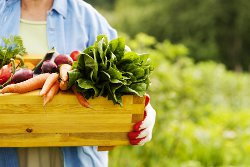From voters to veggies – Using the digital lessons of successful political campaigns to create a new food movement
 When Benzi Ronen started the online farmers market grocery Farmigo in 2009, the vision was “access to just harvested, locally grown food — but we ultimately realized it was about building community.”
When Benzi Ronen started the online farmers market grocery Farmigo in 2009, the vision was “access to just harvested, locally grown food — but we ultimately realized it was about building community.”
Rather than focus on economies of scale, Ronen is building what he calls “economies of community” — and it’s no marketing gimmick. Farmigo depends heavily on word of mouth and, in particular, the passion and loyalty of a cadre of core customers, called “Farmigo Organizers,” who share Farmigo’s mission and help launch these virtual food cooperatives.
Essentially, the organizers — regular people who just want to support the local food movement — act as grassroots evangelists to recruit new customers in their neighborhoods and social circles.The model combines smart marketing with true grassroots organizing, and it’s no accident that Farmigo’s marketing team is led by some of the superstars of Barack Obama’s presidential campaigns.
The business started in the Bay Area in 2009 but moved its headquarters to Brooklyn almost two years ago. Ronen sees Brooklyn as ground zero for local artisanal food. Farmigo has about $10 million in venture backing and, based on its rapid growth, is getting a lot of interest for its next round of financing.
All the food is local — sold directly from local farmers and producers — a designation that’s become so appealing to consumers that in some ways it is surpassing the popularity — although not yet the dollar value — of organics. Like most local food, Farmigo’s offerings come with their own stories, straight from the farmers and producers who supply the food each week. Narratives have become a major part of the shopping, cooking and eating experience for consumers — a key aspect of the movement toward fresh, less processed food. Farmigo’s producer stories are available online, but they’re also an integral part of what people talk about when they share their love of Farmigo.
Farmigo now has hundreds of communities with thousands of members in California, New York and New Jersey, each with a set of 30 to 50 producers supplying them food.
Customers go online each week to order their food for the next delivery and can see where each item is coming from. The delivery is free and the price tends to be about 10 to 15 percent less than farmers markets and supermarkets. There is no food waste since everything is harvested based on what was pre-ordered by the customer. If the customer orders apples from one farmer but the farmer is not able to harvest enough apples to fulfill all the orders, Farmigo will substitute apples from another farmer — and let the customer know about the exchange.
That transparency builds trust, a huge factor in Farmigo’s farm-to-fridge appeal and the appeal of local food in general.
In some ways, Farmigo is bringing farmers markets to consumers. They don’t get to walk around and talk to producers, but they do get a year-round source of produce and other food without trekking to a particular location once a week. “Most of our customers aspire to shop at farmers markets, but can’t,” Ronen said. “Many do shop at farmers markets, and simply need another, reliable source of fresh local food.”
He considers supermarkets his main competition. “We’re creatures of habit, and the habit is the supermarket. We work on shifting your habit to a new way of shopping.”
The delivery process that drives Farmigo is impressive. It has a just-in-time system that has to take into account the productivity guesses of various farmers and producers.
“Initially, there were a lot of growing pains, and farmers weren’t always taking it seriously,” Ronen said. “Now we’re making their business, so they really flex their muscles to deliver.”
Indeed, one farmer, Shankar Venkataraman of Hillview Organics in California, told the San Francisco Chronicle, “Farmigo is a small revolution … It literally saved my business by buying from me.”
